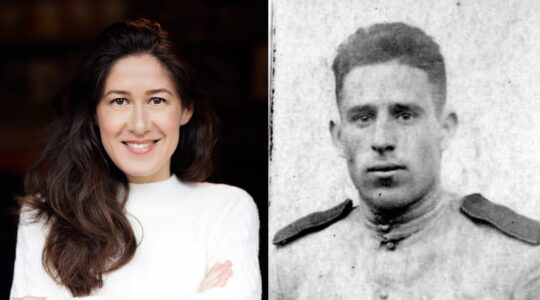The new home of the Magnes Collection for Jewish Art and Life, a Bay Area institution renowned for its archives of material relating to Jews in the American West, displays all the museum’s ambition.
Prominently situated just off the main campus of UC-Berkeley, with which it merged in 2010, it has all the hallmarks of a cutting-edge building: sleek wooden displays made from local re-salvaged elm; floor-to-ceiling glass walls allowing glimpses into the museum’s vast collection of Judaica, the third largest in North America; and a spacious hall for lectures and functions, as well dance, theater and art.
“In the museum model, this accessibility was much harder to achieve,” said Alla Efimova, the Magnes’ director, referring to the collection’s past focus on being more of an art museum than a research and educational facility, as it now primarily sees itself. “The new design was about making the collection accessible and encouraging work with the collection,” she said.
Few doubt that the Magnes’ merger and new home will vastly increase its use, but museum watchers agree that the move comes with some significant costs. Already, Berkeley classes for Jewish studies courses are held weekly in its building. Scholars like Jeffrey Shandler, a professor at Rutgers, are planning not only to use the Magnes’ enormous archives for research, but also to create innovate exhibits based on them.
Not long ago, Shandler began talking with the Magnes’ chief curator, Francesco Spagnolo, about using the archives for a project — likely a book or article — on the Jewish fascination with list making. “He said, ‘This would make a great exhibit,’” Shandler recounted. Now, with the Magnes’ new home having a centrally located gallery, that exhibit is underway, set to open some time later this year.
The new building has been a boon for artists like Emmanuel Witzhum, an Israeli artist-in-residence at Berkeley. He had no plans for an exhibit at the Magnes when he applied to Berkeley, but the museum approached him about exhibiting work. “It was perfect,” he said, “They immediately got the idea.”
Founded 50 years ago by the Bronx-born Jewish educator, Seymour Fromer, the Magnes’ ambitions always exceeded the realities of being a small Jewish museum. Over the years, Fromer and his wife, Rebecca Camhi Fromer, amassed not only the largest archive of Jewish American Western history, but also a treasure trove of exotic Judaica.
Some of the highlights are on view at the Magnes’ inaugural exhibit, titled “The Magnes Effect: Five Decades of Collection.” There is a 19th-century purple velvet wedding dress from Rhodes; a sword given by the Ottoman rulers of Palestine to the Jewish developer, who, in 1892, financed the road connecting Jaffa to Jerusalem; even a century-old ketubah from the Jewish community in Kochi, India.
All these holdings were hard to display in its former home, a cramped residential house in Berkeley, where the museum had been since 1966. “Even Google maps had a hard time giving directions on how to get there,” said Spagnolo, the Magnes’ chief curator.
The Magnes’ new building, along with its merger with Berkeley, has been widely praised by scholars, fundraisers and museum directors alike. As an independent institution until its merger in 2010, the Magnes had limited staff and hours, and found it difficult to preserve and organize its archives. Now that the heart of its collection — the documents of the Jewish American West — sit in the Bancroft Library on campus, accessing them will be considerably easier for scholars.
Moreover, the renovated new building — at 25,000 square feet, roughly three times the size of the collection’s former home — enables it to house 80 percent of its exotic collection of Judaica in-house, not, as it had in the past, in an off-site storage facility. By taking over administrative costs, Berkeley has also cut the Magnes’ annual operating budget in half. Instead of roughly $2 million a year to operate, it will now cost just under $1 million.
But the changes come at a price. Merging the Magnes with a much larger, and secular, institution like Berkeley was never part of Fromer’s vision. He died in 2009, before the decision was made. And the merger only highlights the mishaps and difficult choices the Magnes has had to make simply in order to survive.
“In an ideal situation, it could have remained independent,” said Fred Rosenbaum, another leading scholar of the Jewish American and the West. While acknowledging the ultimate benefits of the merger, he couldn’t help but lament the decision.
“Just a minor caveat,” he said: “There was something wonderful about the old Magnes. There was a kind of feeling in the air of being a part of something special. Now it will be highly efficient, but it won’t have the warmth, the intangible, of being a highly creative independent Jewish institution.”
Perhaps the most important sacrifice Magnes made was the relinquishment of the central item that made it famous in the first place: its collection of Jewish archives of the West. The include the papers of the Haas family, an original owner of Levi Strauss and Company, and many founders of the Bay Area’s Jewish community. All of those documents have been moved to the Berkeley’s Bancroft Library, itself a renowned institution with one of the largest collections of materials relating to the American West.
Many scholars of Jewish history think this is good for Jewish scholarship.
“I think it’s great — it’s better than good,” said Marc Dollinger, chair of the Jewish studies department at San Francisco State University and a leading scholar of Jews in the American West. “It’s better to house [the Jewish West documents] at a research library; it’s more accessible to a wider audience.”
But few deny that the merger was one made out of dire need. A series of inopportune choices, including a hasty merger with the Contemporary Jewish Museum in San Francisco in 2002 (that ended a year later), and the purchase of two new buildings — one just before the dot-com crash in 2000, another before the 2008 recession — left the Magnes badly damaged.
“Ultimately what happened was that we couldn’t agree on anything,” said Connie Wolf, the Contemporary Jewish Museum’s director from 1999 to 2011. (She now directs Stanford’s Iris & B. Gerald Cantor Center for Visual Arts.)
The 2002 merger between Magnes and the CJM was precipitated by economic pressures. Both institutions were looking to grow in the 1990s, but found it difficult to raise money when their main donors came from the same small pool. When the dot-com crash of 2000 hit, raising money become even harder.
Since both institutions had overlapping interests — the Magnes, especially, had always been a leader in artistic programming, creating one of the first Jewish film festivals in the country — their boards figured that hashing out the details would be simple.
They were wrong. The Contemporary Jewish Museum already had mock-up plans for a building designed by Daniel Libeskind, to be built in San Francisco. But Magnes had plans for its own new building in Berkeley.
It quickly became clear to both parties that one of the institutions would have to take a back seat in the partnership, but neither was willing to do so, said Wolf. “What I learned in retrospect,” she said, was that “there is no such thing as a merger. There’s only an acquisition; there’s always going to be one dominant partner.”
After parting ways in 2003, the Magnes resumed its prior goal of building a new home in downtown Berkeley. It embarked on a $30 million fundraising campaign to help finance that dream, and even bought a second building it hoped might be used for a new site. But when the recession hit in 2008, it became obvious that all those plans had to be abandoned.
Moreover, when the Contemporary Jewish Museum finally reopened in its own new home in 2008, in an attention-grabbing Libeskind-designed building, the Magnes found it even more difficult to raise funds for an ambitious new building of its own.
“We realized at that point that we were never going to raise the $30 million” for a new building in Berkeley, said Frances Dinkelspiel, the former president of Magnes’ board or directors, who oversaw the 2010 merger.
So when Berkeley came along in 2010, offering the Magnes the chance to maintain a separate identity — as long as it handed over its prized collection of Western Jewish archives — Magnes’ board quickly agreed.
“Everyone said yes,” recounted Dinkelspiel.
Part of the deal was that Magnes would disband its independent board. So Dinkelspiel is now part of an advisory council for the Magnes that can only offer advice to Berkeley. To afford its new home, it simply renovated the building it bought in 1997, which it had planned to tear down and build over from scratch. The renovation cost $3 million, a fraction of the original $30 million plan, and was largely financed by the sale of the collection’s old home.
The Magnes must also continue to do all its own fundraising. “Berkeley’s not giving us anything,” said Dinkelspiel, though she added that the university is hiring a part-time development officer to help the Magnes fundraise.
The Magnes has enough money saved — it raised roughly $10 million of the planned $30 million goal — to guarantee its current budget for another four years. But after that, one of the main issues that has significantly hindered its fundraising abilities over the past several years — competition for fundraising with the Contemporary Jewish Museum — will return.
Despite all this, Dinkelspiel, like many other people interviewed, say SAYS that the benefits of the merger with Berkeley far outweigh the costs.
“Our identity has become better defined,” she said. “We thought that the Magnes would gain in profile by being affiliated with Berkeley. … Everything the Magnes has dreamed of has come to pass.”
The New York Jewish Week brings you the stories behind the headlines, keeping you connected to Jewish life in New York. Help sustain the reporting you trust by donating today.




